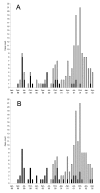Community-associated methicillin-resistant Staphylococcus aureus, Canada - PubMed (original) (raw)
Community-associated methicillin-resistant Staphylococcus aureus, Canada
Michael R Mulvey et al. Emerg Infect Dis. 2005 Jun.
Abstract
A total of 184 methicillin-resistant Staphylococcus aureus (MRSA) strains were collected from patients who sought treatment primarily for skin and soft tissue infections from January 1, 1999, to March 31, 2002, in east-central Saskatchewan, Canada. Molecular subtyping analysis using pulsed-field gel electrophoresis showed 2 major clusters. Cluster A (n = 55) was composed of a multidrug-resistant MRSA strain associated with a long-term care facility and was similar to the previously reported nosocomial Canadian epidemic strain labeled CMRSA-2. Cluster B (n = 125) was associated with cases identified at community health centers and was indistinguishable from a community-associated (CA)-MRSA strain identified previously in the United States (USA400). Cluster B remained susceptible to a number of classes of antimicrobial agents and harbored the lukF-PV and lukS-PV toxin genes. Over 50% of both clonal groups displayed high-level resistance to mupirocin. This is the first report of the USA400 strain harboring the lukF-PV and lukS-PV toxin genes in Canada.
Figures
Figure 1
Epidemiologic curve showing the emergence of methicillin-resistant Staphylococcus aureus (MRSA) in central-eastern Saskatchewan. A) Number of nonrepeat cases over the length of study; solid bars, cases identified in a long-term care facility; gray bars, cases identified in community health centers. B) Same data as (A), with solid bars representing isolates of clone A and gray bars showing isolates of clone B.
Figure 2
A) Pulsed-field gel electrophoresis (PFGE) fingerprint of USA400 and PFGE pattern B1. B) Dendrogram showing relationship of the unique fingerprints, along with the PFGE type designation (11) and other molecular characteristics of each subtype. CDN, Canadian Diseases Network; MLST, multilocus sequence typing; SCC, staphylococcal chromosome cassette.
Figure 3
Age distribution of patients with cases caused by each clonal type A (white bars) or type B (black bars).
Similar articles
- Epidemiology and molecular characteristics of community-associated methicillin-resistant and methicillin-susceptible Staphylococcus aureus from skin/soft tissue infections in a children's hospital in Beijing, China.
Wu D, Wang Q, Yang Y, Geng W, Wang Q, Yu S, Yao K, Yuan L, Shen X. Wu D, et al. Diagn Microbiol Infect Dis. 2010 May;67(1):1-8. doi: 10.1016/j.diagmicrobio.2009.12.006. Epub 2010 Mar 12. Diagn Microbiol Infect Dis. 2010. PMID: 20227225 - Community-associated methicillin-resistant and methicillin-sensitive Staphylococcus aureus: skin and soft tissue infections in Hong Kong.
Ho PL, Chuang SK, Choi YF, Lee RA, Lit AC, Ng TK, Que TL, Shek KC, Tong HK, Tse CW, Tung WK, Yung RW; Hong Kong CA-MRSA surveillance network. Ho PL, et al. Diagn Microbiol Infect Dis. 2008 Jul;61(3):245-50. doi: 10.1016/j.diagmicrobio.2007.12.015. Epub 2008 Feb 12. Diagn Microbiol Infect Dis. 2008. PMID: 18272316 - Prospective comparison of methicillin-susceptible and methicillin-resistant community-associated Staphylococcus aureus infections in hospitalized patients.
Skiest DJ, Brown K, Cooper TW, Hoffman-Roberts H, Mussa HR, Elliott AC. Skiest DJ, et al. J Infect. 2007 May;54(5):427-34. doi: 10.1016/j.jinf.2006.09.012. Epub 2006 Oct 27. J Infect. 2007. PMID: 17070598 - Epidemiology, clinical manifestations, and treatment options for skin and soft tissue infection caused by community-acquired methicillin-resistant Staphylococcus aureus.
Farley JE. Farley JE. J Am Acad Nurse Pract. 2008 Feb;20(2):85-92. doi: 10.1111/j.1745-7599.2007.00290.x. J Am Acad Nurse Pract. 2008. PMID: 18271763 Free PMC article. Review.
Cited by
- Methicillin-Resistant Staphylococcus aureus Ocular Infection in Taiwan: Potential Role of Panton-Valentine Leukocidin Gene.
Liu YT, Kang EY, Chen YL, Yeh LK, Ma DHK, Chen HC, Hung KH, Huang YC, Hsiao CH. Liu YT, et al. Transl Vis Sci Technol. 2023 Apr 3;12(4):18. doi: 10.1167/tvst.12.4.18. Transl Vis Sci Technol. 2023. PMID: 37067364 Free PMC article. - Intolerable Burden of Impetigo in Endemic Settings: A Review of the Current State of Play and Future Directions for Alternative Treatments.
Abrha S, Tesfaye W, Thomas J. Abrha S, et al. Antibiotics (Basel). 2020 Dec 15;9(12):909. doi: 10.3390/antibiotics9120909. Antibiotics (Basel). 2020. PMID: 33333955 Free PMC article. Review. - Comparing the use of a novel antibiotic-free film-forming topical wound dressing versus a topical triple antibiotic in dermatologic surgical procedures including Mohs micrographic surgery.
Benedetto AV, Staidle JP, Schoenfeld J, Benedetto EA, Benedetto PX. Benedetto AV, et al. J Eur Acad Dermatol Venereol. 2021 Jan;35(1):247-255. doi: 10.1111/jdv.16965. Epub 2020 Nov 12. J Eur Acad Dermatol Venereol. 2021. PMID: 32978842 Free PMC article. Clinical Trial. - Antimicrobial Resistance in ESKAPE Pathogens.
De Oliveira DMP, Forde BM, Kidd TJ, Harris PNA, Schembri MA, Beatson SA, Paterson DL, Walker MJ. De Oliveira DMP, et al. Clin Microbiol Rev. 2020 May 13;33(3):e00181-19. doi: 10.1128/CMR.00181-19. Print 2020 Jun 17. Clin Microbiol Rev. 2020. PMID: 32404435 Free PMC article. Review. - Methicillin-resistant Staphylococcus aureus in food and the prevalence in Brazil: a review.
da Silva AC, Rodrigues MX, Silva NCC. da Silva AC, et al. Braz J Microbiol. 2020 Mar;51(1):347-356. doi: 10.1007/s42770-019-00168-1. Epub 2019 Oct 30. Braz J Microbiol. 2020. PMID: 31667799 Free PMC article. Review.
References
- Centers for Disease Control and Prevention. Four pediatric deaths from community-acquired methicillin-resistant Staphylococcus aureus—Minnesota and North Dakota, 1997–1999. MMWR Morb Mortal Wkly Rep. 1999;48:707–10. - PubMed
Publication types
MeSH terms
Substances
LinkOut - more resources
Full Text Sources
Other Literature Sources
Medical


